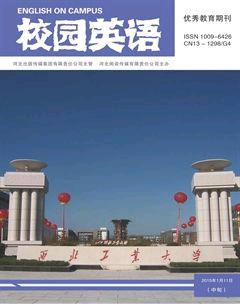Cultural Implications of Dragon in The Woman Warrior
储俏
The Woman Warrior,written by Maxine Hong Kinston,won the National Book Critic Circle Award for the best work of nonfiction in 1976.It was also acclaimed as one of the top nonfiction books of the 1970s by Time Magazine.As a second generation immigrant female writer being raised in California,Kingston was in an awkward dilemma hovering between the east and the west.In defiant of the prejudices suffered by the traditional women and Chinese immigrants in the west,The Woman Warrior aims to seek and construct an independent cultural identity.
Soon after its publication,The Woman Warrior receives high acclaims from the native reviewers.Jane Kramer describes it as “a brilliant memoir…an investigation of soul,not landscape” (Huntley).Once hailed as a ground-breaking book that marks a new epoch of contemporary Chinese American literature,The Woman Warrior attracts wide attention focusing on cross-cultural issues,racial identification and relationships between first and second generation immigrants through cultural nationalism,post-colonialism,feminism,and so forth.This paper then explores the authors realization of the cultural sense by analyzing the image of Dragon.
The“White Tigers”starts with the sentence“When we Chinese girls listened to adults talk-story,we learned that we failed if we grew up to be but wives or slaves”(Kingston,19),which implies that the author sets out to defy against the traditional values about Chinese women.The previous chapter“No Name Woman”represents the tragic fate of women,and Kingston stresses the unreasonable prejudices against them in old Chinese society.It is in the second chapter that she fights against traditional values by portraying a powerful image of a woman warrior,in which various images are displayed as the embodiment of culture.Many animals convey far-reaching cultural implications,such as the image of dragon and bird.
China is considered the birth place of dragon.And its presence can be traced back to six thousand years ago.Though nonexistent,dragons are symbolized as a unique trait of Chinese cultures,which are depicted in pictures,carvings,coins and at one time,the emperors robes.For the Chinese,the dragon also symbolizes masculinity,power,success,intelligence,and wealth.
The image of dragon symbolizes many things in this chapter.Firstly,dragon is traditionally symbolizes the concept of yang (male) and a strong sense of male power in Chinese culture.As the author says“After I returned from my survival test,the two old couple trained me in dragon ways,which took another eight years”(Kingston,28),which implies that the mountain test is an extremely tough challenge only those males are strong enough to go through.In order to succeed,she has to behave like a male,that is,a dragon.The tests of the woman warrior illustrate the empowerment of women by putting her through difficult situations that she must overcome.
Secondly,dragon is an equivalent to the profound Chinese culture.Since the origin of dragon is not known yet and no telling evidence suggests its existence,men have no clear knowledge about this special animal.Just as Kingston says that one has to“infer the whole dragon from the parts you can see and touch”(Kingston,28),here the dragon is the symbol of traditional Chinese culture.She grows up with the conflicting stories told by her mother,ideas and cultures learned from immigrants in the China-town,and she must infer much about the rest of the Chinese culture from other ways.The image of dragon penetrates into and has strong influence upon the daily life.“The dragon lives in the sky,ocean,marshes,and mountains;and the mountains are also its cranium.Its voice thunders and jingles like copper pans.It breathes fire and water; and sometimes the dragon is one,sometimes many” (Kingston,29).Dragon is integrated into and becomes a part of Chinese culture.
At last,dragon represents the strong will and courage possessed by powerful man.Kingston later reveals that she and her mother were born in the year of the dragon,My mother may have been afraid,but she would be a dragoness (‘my totem,your totem).She musters up all the courage to combat with the “ghost”.During danger “she fanned out her dragon claws and riffled her red sequin scales and unfolded her coiling green stripes.Danger was a good time for showing off like the dragons living in temple eaves,my mother looked down on plain people who were lonely and afraid.” (Kingston,67) The determination to break the traditional rules is clear when the author frequently combines their fights with dragon.
On the whole,the image of dragon appears quite often in The Woman Warrior.Despite various implications it conveys,dragon is fundamentally a symbol of traditional Chinese culture.And the authors use of this image suggests the strong sense of her Chinese identity.Thus it becomes reasonable enough for her to claim her self identity in a bi-cultural context.However,as one who grows up in a patriarchal environment,Kingston confronts a lot of ill treatments from the bias against girls in Chinese community.When being a child,she is afraid of being sold into slavery or wifehood due to the long-established prejudices among people.“Feeding girls is feeding cowbirds” “There's no profit in raising girls.Better to raise geese than girls” “when you raise girls,you're raising children for strangers”.Such sayings fill the air around her.
Unbearable to the surrounding voices against women,Kingston tries to change her status.She attempts resistance by trying to deny her femaleness,especially by breaking the established codes for female behavior:achieving academic success,behaving clumsily,breaking dishes,refusing to cook.And her resistance to the norms gives her reason to gloat when accused of being a“bad girl”.Nevertheless,the Chinese traditional culture is so deeply rooted in the authors mind,and she tries every means to give a say to the voices of women.

